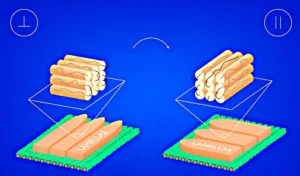An international team of researchers headed by Dimitri Ivanov of the Laboratory of Functional Organic and Hybrid Materials at the Moscow Institute of Physics and Technology (Moscow, Russian Federation) is developing a new means for aligning liquid crystals. The technique is said to have the potential to increase the field of view of liquid crystal displays.
A recent article on this subject by the team is entitled “One Methylene Group in the Side Chain Can Alter by 90 Degrees the Orientation of a Main-Chain Liquid Crystal on a Unidirectional Substrate.” It was published on-line on March 23 and in the journal ACS Macro Lett., 2018, 7 (4), pp 453-458. A copy of the article is available for purchase here.
The matter investigated by the researchers relates to a problem that occurs in the ubiquitous twisted nematic liquid crystal display. The problem is that the contrast, brightness and color of the image can change across the display’s the field of view.
A simple minded explanation for the reason that the image changes relates to the ways in which light rays traveling through the display interact with the optical components within the display. The interaction of interest in this study was that of the light rays with the layer of liquid crystal material. More specifically, it was the angular relationship between the direction traveled by transiting light rays and the alignment directions of the liquid crystal molecules. Some angles result in an image having the intended qualities while other angles result in an image in which the image qualities have changed.
One of the several means that have been developed to address the issue of image change is the use of so-called multidomain alignment. In this approach, each pixel is subdivided into a number of domains, each domain having a different alignment direction. By integrating several different alignment directions into each pixel, several different angular relationships will occur between the transiting light rays and the liquid crystal and, thus, it becomes likely that at least some of the domains will be oriented so as to provide the intended image qualities at any location within the field of view.
In their current research, the team is developing a new and improved means to produce displays with multidomain alignment. The article provides a great deal of information on the materials and techniques used in the alignment process. Here is a top level summary.
As a first step in their experiments, the researchers prepared a substrate having a surface coated with a layer of rubbed Teflon. The function of the rubbing was to induce a regular pattern of microscopic grooves in the Teflon layer.
In the next step, the researchers used liquid crystal polymers. The class of polymers used in the study are poly(di-n-alkylsiloxanes), or PDAS. Each PDAS molecule is a chain containing alternating silicon and oxygen atoms. The silicon atoms in PDAS bear two symmetric hydrocarbon side chains.
An assembly of the elongated polymer molecules can form a superstructure that is known as a lamellae. Within the assembly, the long axis of the polymer molecules are perpendicular to the long axis of the lamellae.
A layer of PDAS was then coated onto the rubbed Teflon. Previous research has reported that crystalline polymers align on such a grooved substrate.
Next, a layer of nematic liquid crystal was coated on the PDAS layer. The researchers then went on to examine the orientation of the liquid crystal polymer chains relative to the direction of the grooves on the Teflon aligning surface. In a series of experiments, the length of the side chains of the PDAS polymer were systematically increased in steps of 1 from 2 groups to 6 groups. It was found that the orientation of the lamellae and hence the PDAS and, ultimately, the alignment direction of the liquid crystal varied according to the number of groups in the side chain of the PDSA.
- Given 2 groups, the polymer chains were perpendicular to the grooves on the substrate. This is illustrated in the in the left hand portion of the figure below. As a result, the liquid crystal polymer chains were now oriented perpendicular to the grooves.
- Given 3 groups, the polymer chains were found to be parallel to the grooves. As a result, the liquid crystal polymer chains were now oriented parallel to the grooves. This is illustrated in the right hand portion of the figure below.
- Given 4 groups, no further change in orientation was observed.
- When the side chain length was further increased to 5 and 6 groups, the polymer chains aligned perpendicular to the Teflon grooves.
Two possible orientations of liquid crystal molecules relative to the rubbed Teflon substrate. On the left, polymer chains (wavy black line) and the grooves on the alignment surface (green) are orthogonal. On the right, they are parallel.
In summary, the researchers demonstrated that two orthogonal liquid crystal alignment directions could be produced on the same unidirectionally rubbed substrate. In a multidomain display application, an appropriate polymer would be applied to each domain of each pixel in order to obtain a desired liquid crystal alignment direction.
The researchers believe that their new alignment technology can be a simpler and less expensive means to produce multidomain displays than technologies currently in use. -Arthur Berman
Moscow Institute of Physics and Technology, Dimitri A. Ivanov, [email protected]

